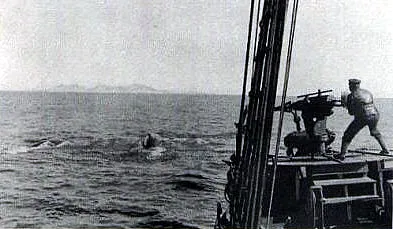Greenland Whaling
Whales and
Whaling pictures
Next
Previous
Back to gallery
Back to whale and whaling
thumbnails

Greenland Whaling approx. WWl. The gunner is aiming an exploding harpoon loaded into the cannon set in the bow of a whaling catcher boat.
The whole process of whaling was changed drastically when Norwegian Sven Foyn invented the exploding harpoon in 1864. By doing so, he removed much of the immediate danger from whaling (though it remained a very dangerous task), but more than anything - increased the efficiency by which whales could be captured and made it possible to hunt the larger and faster rorquals (baleen whales).
The gun enabled the harpooner to hit a whale 50 yards away, no longer needing to be next to the whale in a small wooden boat. On entering the whale, the barbs of the harpoon opened breaking a small phial of sulphuric acid which set off a fuse to explode the bomb. So in a single action, the old hand-thrown harpoon and hand wielded lance were rendered obsolete along with the need to get close to the whale.
Similar explosively fired harpoons had been around for several decades, but it was Foyn who after much trial and experimentation perfected a workable and effective solution. Such a new invention also required other improvements to the boats, catching and processing gear to make the most effective use of it. In particular such a heavy harpoon gun needed a stronger boat to be used on, so Foyn converted a steam whale catcher built the year before in 1863, the Spes et Fides to take his new harpoon gun. The Spes et Fides thus became the very first modern whale catching boat.
This was the invention that allowed for industrial whaling to begin, an event from which the world's whaling stocks and oceanic ecosystems have yet to recover.
